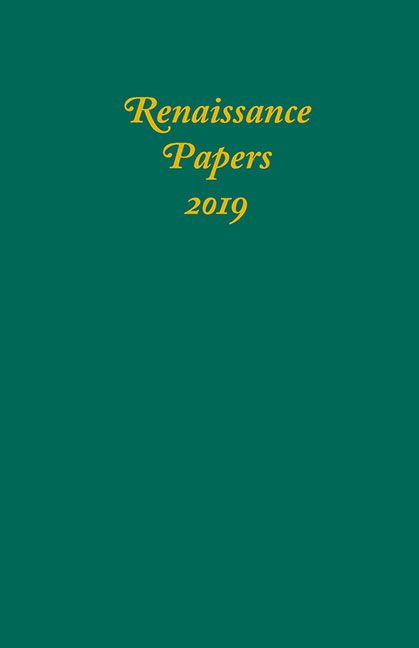Book contents
- Frontmatter
- Contents
- Dedication
- The Names’ Two Bodies: Mary, Queen of Scots, Elizabeth I, and the Politics of Correspondence
- “Of that Wide Gap”: Liminality and the Gap of Time in The Winter’s Tale
- “To kill a Wife with Kindness”: Contextualizing Shakespeare’s The Taming of the Shrew
- The Harvest of Mysticism in English Renaissance Literature: Ascesis in Spenser and Shakespeare— “silencing the tumult of the flesh”
- A House of Spiderwebs: George Herbert and the Estate Poem
- The Judith Narrative in Margaret Tyler’s Mirror of Princely Deeds
- Knowing Owen: Merry and Satirical Epitaphs on a Butler of Christ Church, Oxford
- Margaret Cavendish and Ben Jonson: Ladies’ Spaces, Boy Actors, and Wit
- Parnassus Commodified: Ben Jonson and the Printing of Value
“Of that Wide Gap”: Liminality and the Gap of Time in The Winter’s Tale
Published online by Cambridge University Press: 23 October 2020
- Frontmatter
- Contents
- Dedication
- The Names’ Two Bodies: Mary, Queen of Scots, Elizabeth I, and the Politics of Correspondence
- “Of that Wide Gap”: Liminality and the Gap of Time in The Winter’s Tale
- “To kill a Wife with Kindness”: Contextualizing Shakespeare’s The Taming of the Shrew
- The Harvest of Mysticism in English Renaissance Literature: Ascesis in Spenser and Shakespeare— “silencing the tumult of the flesh”
- A House of Spiderwebs: George Herbert and the Estate Poem
- The Judith Narrative in Margaret Tyler’s Mirror of Princely Deeds
- Knowing Owen: Merry and Satirical Epitaphs on a Butler of Christ Church, Oxford
- Margaret Cavendish and Ben Jonson: Ladies’ Spaces, Boy Actors, and Wit
- Parnassus Commodified: Ben Jonson and the Printing of Value
Summary
IN The Empty Space, Peter Brook's examination of the theater and theatricality, Brook writes, “We are aware that most of life escapes our senses: a most powerful explanation of the various arts is that they talk of patterns which we can only begin to recognize when they manifest themselves as rhythms or shapes.” In his chapter on the “Holy Theater,” Brook creates a new perspective on the theater; there he argues that life is reflected on the stage and that the patterns of the theater are reflections of the patterns of society. The mirroring of society in the theater, and the ways in which the patterns and rhythms of both reflect our experiences back to us, helps to untangle the ways in which we are vexed by the convoluted nature of drama. In The Winter's Tale, Brook's rhythms and shapes are manifested through a gap of time that is at once temporal, physical, and uniquely liminal. The shape of the gap of time is human, as Time himself walks on stage to “slide / O’er sixteen years, and leave the growth untried / Of that wide gap,” but the space of the gap of time is indeterminate in its liminality (4.1.5–6).
While the space of the gap of time is difficult to assess, the shape is not. The pregnant body of the queen, itself a liminal space between conception and birth, is the first hint of the liminal at play within the drama. The rhythm of life and the shape of the queen's body are patterns that we recognize within the play because they replicate the patterns present in early modern social practices. The pattern at the center of the gap of time is the liminal stage within rites of passage as established by Arnold van Gennep and augmented by Victor Turner. This paper posits that the gap of time, Time himself on stage, is a creation. The gap of time responds to and is a product of Paulina's agency as the guide, responsible for the success of the neophyte within the liminal stage of the rite of passage.
- Type
- Chapter
- Information
- Renaissance Papers 2019 , pp. 13 - 36Publisher: Boydell & BrewerPrint publication year: 2020



